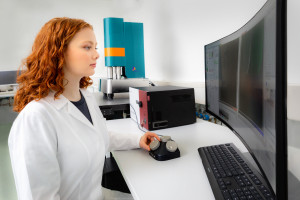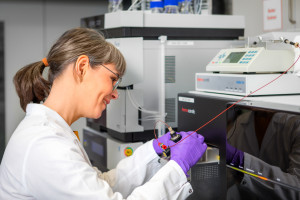-
In seinen Forschungsprogrammen verfolgt das ISAS die Entwicklung verschiedener analytischer Verfahren für eine skalenübergreifende Multiparameter-Analyse in der Gesundheitsforschung. Ziel ist es, damit die komplexen Herausforderungen an eine Analytik für die personalisierte Medizin (Präzisionsmedizin) anzugehen.
Die vier Forschungsprogramme des Instituts sind über zahlreiche wissenschaftliche und technologische Fragestellungen miteinander verzahnt. Durch die interdisziplinäre Zusammenarbeit entstehende Synergien kommen den Forschungsprojekten innerhalb eines Programms so zugute. Die Kombination komplementärer analytischer Verfahren spielt dabei für die Entwicklung neuer Multimethoden-Konzepte für die Gesundheitsforschung eine zentrale Rolle.
-
Dabei steht der anwendungsspezifische Einsatz der Analytik stets im Fokus. Die Programme konzentrieren sich auf: die Aufklärung von Krankheitsmechanismen und Identifikation möglicher Therapieansätze – beide mit Anwendungsbezug für die spätere präklinische Forschung; die Identifikation und Detektion diagnostischer, prognostischer und therapeutischer Marker; die orts- und zeitaufgelöste, möglichst in vivo Darstellung von Prozessen von der molekularen bis hin zur zellulären Ebene; nicht-invasive und zerstörungsfreie Analysemethoden.
Forschungsprogramme
Publikationen
Coral Reefs, 2025
Stuhr M, Kollipara L, Reymond CE, de Beer D, Ries J, Sickmann A, Westphal H.
Differing proteome responses to ocean acidification between two common pocilloporid corals
https://doi.org/10.1007/s00338-025-02801-y
Journal of Proteome Research, Bd. 2025, 2025
Lange E, Schallert K, Schwerdt J, Ghosh S, Hentschel A, Reinders Y, Heyer R.
The Omics Molecule Extractor: A Web Application for the Selection of Potential Biomarker Panels
https://doi.org/10.1021/acs.jproteome.5c00176
Npj imaging, Bd. 2025, Nr. 3, 2025
Pan Z, Sonneck J, Nagel D, Hasenberg A, Gunzer M, Shi Y, Chen J.
AutoQC-Bench: a diffusion model and benchmark for automatic quality control in high-throughput microscopy
https://doi.org/10.1038/s44303-025-00117-8
Naunyn-Schmiedeberg's Archives of Pharmacology, Bd. 2025, 2025
Lorenz K, Ravens U.
Finn Waagstein and the paradigm shift in the treatment of heart failure with β-adrenergic receptor antagonists (‘β-blockers’)
https://doi.org/10.1007/s00210-025-04594-x
Redox Biology, Bd. 86, 2025
Shen TK, Vignane T, Gilglioni EH, Traini L, Kalaitsidou E, Conan P, Li A, St-Pierre-Wijckmans W, Herranz JM, Elvira B, Sanchez LO, Trépo E, Deelman…
Metabolic dysfunction-associated steatohepatitis reduces hepatic H2S-producing enzymes altering persulfidome composition
https://doi.org/10.1016/j.redox.2025.103809
Acta Neuropathologica, Bd. 2025, Nr. 1, 2025
Stascheit F, Roos A, Schroeter CB, Thomas JK, Hahn K, Preßler H, Hentschel A, Schlotter-Weigel B, Schoser B, Ruck T, Meisel A, Stenzel W, Preusse C.
Complement profiling of sural nerves in chronic inflammatory demyelinating polyneuropathy
https://doi.org/10.1007/s00401-025-02936-w
Metabolomics, Bd. 21, Nr. 5, 2025
Alwahsh M, Alejel R, Hamadneh L, Aleidi SM, Marchan R, Hasan A, Jasim S, Saqallah FG, Al-Kouz S, Hussein B, Alhusban AA, Al-Hiari Y, Al-Qirim T,…
Identification of potential biomarkers of triton WR-1339 induced hyperlipidemia: NMR-based plasma metabolomics approach and gene expression analysis
https://doi.org/10.1007/s11306-025-02318-z
The Journal of Applied Laboratory Medicine, Bd. 10, Nr. 5, 2025, S. 1226-1240
Walke D, Steinbach D, Kaiser T, Schönhuth A, Saake G, Broneske D, Heyer R.
SBC-SHAP: Increasing the Accessibility and Interpretability of Machine Learning Algorithms for Sepsis Prediction
https://doi.org/10.1093/jalm/jfaf091



